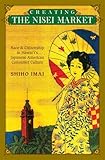Creating the Nisei Market : Race and Citizenship in Hawaii's Japanese American Consumer Culture / Shiho Imai.
Material type: TextPublisher: Honolulu : University of Hawaii Press, [2010]Copyright date: ©2010Description: 1 online resource (232 p.) : 15 illus., 9 tablesContent type:
TextPublisher: Honolulu : University of Hawaii Press, [2010]Copyright date: ©2010Description: 1 online resource (232 p.) : 15 illus., 9 tablesContent type: - 9780824833329
- 9780824860431
- Consumption (Economics) -- Social aspects -- Hawaii -- Honolulu -- History
- Japanese Americans -- Cultural assimilation -- Hawaii -- Honolulu
- Japanese Americans -- Hawaii -- Honolulu -- Economic conditions
- Japanese Americans -- Hawaii -- Honolulu -- Social conditions
- SOCIAL SCIENCE / Ethnic Studies / Asian American Studies
- 996.9004956
- E184.J3
- online - DeGruyter
- Issued also in print.
| Item type | Current library | Call number | URL | Status | Notes | Barcode | |
|---|---|---|---|---|---|---|---|
 eBook
eBook
|
Biblioteca "Angelicum" Pont. Univ. S.Tommaso d'Aquino Nuvola online | online - DeGruyter (Browse shelf(Opens below)) | Online access | Not for loan (Accesso limitato) | Accesso per gli utenti autorizzati / Access for authorized users | (dgr)9780824860431 |
Frontmatter -- Contents -- Acknowledgments -- Introduction -- Chapter One. The Markers of Whiteness -- Chapter Two. Creating the Nisei Market -- Chapter Three. Nisei Womanhood and the Culture of Personality -- Chapter Four. Competing Visions of Nisei Consumer Culture -- Chapter Five. The Two Faces of Ethnic Business -- Epilogue -- Notes -- Bibliography -- Index
restricted access online access with authorization star
http://purl.org/coar/access_right/c_16ec
In 1922 the U.S. Supreme Court declared Japanese immigrants ineligible for American citizenship because they were not "white," dismissing the plaintiff's appeal to skin tone. Unable to claim whiteness through naturalization laws, Japanese Americans in Hawai'i developed their own racial currency to secure a prominent place in the Island's postwar social hierarchy. Creating the Nisei Market explores how different groups within Japanese American society (in particular the press and merchants) staked a claim to whiteness on the basis of hue and culture. Using Japanese- and English-language sources from the interwar years, it demonstrates how the meaning of whiteness evolved from mere physical distinctions to cultural markers of difference, increasingly articulated in material terms.Nisei consumer culture demands examination because consumption was vital to the privilege-making process that spilled over into public life. Although economically motivated, Japanese American shopkeepers worked hard to support the next generation of merchants and secure the future of the Nisei consumer market. Far from its image as a static society, the Japanese American community was constantly reinventing itself to meet changing consumer demands and social expectations. The author builds on recent scholarship that considers ethnic communities within a trans-Pacific context, highlighting ethnic fluidity as a strategy for material and cultural success.Yet even as it assumed a position of conformity, the Japanese American consumer culture that took hold among Honolulu's middle class was distinct. It was at once modern and nostalgic, like the wayo secchu ideal-a hybrid of Western and Japanese notions of beauty and femininity that linked the ethnic group to the homeland and mainstream U.S. culture. By focusing on the marketing of whiteness that connected the old world and new, Creating the Nisei Market reveals the dynamic commercial and cultural environment that underwrote the rise of the Nisei in Hawai'i.
Issued also in print.
Mode of access: Internet via World Wide Web.
In English.
Description based on online resource; title from PDF title page (publisher's Web site, viewed 02. Mrz 2022)


